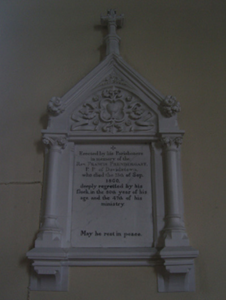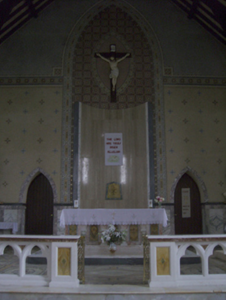Survey Data
Reg No
15702542
Rating
Regional
Categories of Special Interest
Architectural, Artistic, Historical, Scientific, Social, Technical
Original Use
Church/chapel
In Use As
Church/chapel
Date
1855 - 1860
Coordinates
292722, 137155
Date Recorded
21/08/2007
Date Updated
--/--/--
Description
Detached four-bay double-height single-cell Catholic church, built 1856, on a rectangular plan with single-bay single-storey gabled projecting porch to entrance (east) front. "Improved", 1934, producing present composition. Renovated, 1956, with interior "improved". Renovated, ----, with sanctuary reordered. Pitched slate roofs including pitched (gabled) slate roof (porch), moss-covered cut-granite "slated" coping to gables on trefoil-detailed gabled "Cavetto" kneelers including moss-covered cut-granite "slated" coping to gable to chancel (west) on trefoil-detailed gabled "Cavetto" kneelers with granite ashlar buttressed gabled bellcote to apex framing cast-bronze bell, and cast-iron rainwater goods on slate flagged eaves retaining cast-iron downpipes. Part repointed tuck pointed snecked rubble stone walls with benchmark-inscribed cut-granite flush quoins to corners. Pointed-arch window openings with cut-granite Y-mullions, and cut-granite block-and-start surrounds having chamfered reveals framing storm glazing over fixed-pane fittings having cast-iron lattice glazing bars. Cusped lancet window openings (west) with cut-granite block-and-start surrounds having chamfered reveals framing storm glazing over fixed-pane fittings having leaded stained glass panels. Pair of lancet window openings to entrance (east) front with cut-granite block-and-start surrounds having chamfered reveals framing fixed-pane fittings having stained glass margins centred on lattice glazing bars. Pointed-arch window opening (porch) with cut-granite Y-mullion, and cut-granite block-and-start surround having chamfered reveals framing fixed-pane fittings having cast-iron lattice glazing bars. Pointed-arch opposing door openings to "cheeks" with cut-granite surrounds having chamfered reveals framing timber boarded doors. Interior including vestibule (east); square-headed door opening into nave with replacement glazed timber double doors; full-height interior open into roof with carpeted aisles between cruciform-detailed timber pews, grouped Gothic-style timber stations, cut-white marble scroll wall monuments (ob. 1874; 1892) with pair of cut-white marble Gothic-style wall monuments (ob. 1860; 1898), cut-veined white marble stepped dais to sanctuary (west) reordered, ----, with arcaded communion railings centred on cut-veined pink marble panelled altar (1931), and exposed braced scissor truss timber roof construction on cut-granite beaded corbels with wind braced rafters to plywood sheeted ceiling. Set in landscaped grounds with granite ashlar piers to perimeter having shallow pyramidal capping supporting replacement mild steel double gates.
Appraisal
A church erected under the aegis of Reverend Francis Prendergast PP (1782-1860), and with financial support from Sir Robert Shapland Carew (1787-1856) or Sir Robert Shapland Carew (1818-81) of Castleboro House (Lacy 1863, 480), representing an important component of the mid nineteenth-century ecclesiastical heritage of County Wexford with the architectural value of the composition, one recalling the contemporary Catholic Church of Our Lady and Saint Carthage (1856-9), Courtnacuddy (see 15702514), suggested by such attributes as the compact rectilinear "barn" plan form, aligned along an inverted liturgically-correct axis; the construction in an ochre-coloured fieldstone offset by silver-grey granite dressings not only demonstrating good quality workmanship, but also producing a pleasing palette; the "pointed" profile of the openings underpinning a "medieval" Gothic theme; and the handsome bellcote embellishing the roofline as a picturesque eye-catcher in the landscape. Having been well maintained, the elementary form and massing survive intact together with quantities of the historic or original fabric, both to the exterior and to the interior reordered (----) in accordance with the liturgical reforms sanctioned by the Second Ecumenical Council of the Vatican (1962-5) where contemporary joinery; restrained wall monuments signed by John Coates (----) of Dublin and James Pearse (1839-1900) of Great Brunswick Street [Pearse Street], Dublin; the Murphy-Keating Memorial Window signed by Franz Mayer and Company (established 1847) of Munich and London; a polychromatic altar; and gilded mosaic work, all highlight the artistic potential of the composition: meanwhile, an exposed timber roof construction pinpoints the engineering or technical dexterity of a church making a pleasing visual statement in a rural street scene.

























































